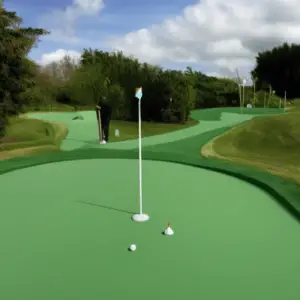Last Updated on May 29, 2023
Mini golfing is an exhilarating challenge that necessitates skill, strategy and a hint of fortune. Whether you’re new to the sport or a seasoned pro looking for some tips on how to play minigolf better, this blog post has got you covered. From equipment needed to course layout and rules of play – we’ll take a look at all the basics so you can hit that holes-in-one with ease. Plus, get insider strategies from experienced players on how they manage their way around the course in record time. So let’s tee off into our exploration of playing mini golf like never before.
Table of Contents:
- Equipment Needed
- Course Layout
- Rules of Play
- Strategies for Success
- FAQs in Relation to How to Play Mini Golf
- Conclusion
Equipment Needed
Golf is a great game to play, and it’s even more fun when you have the right equipment. Mini golf is no exception. To begin, a putter, some balls and a scorecard are required for mini golf.
The putter is the most important piece of equipment for mini golf. Putters come in all shapes and sizes, so make sure to find one that fits your style of play. Try out a variety of putters to determine which is the most suitable for your playing style.
Golf balls are also essential for playing mini golf. Most courses provide their own set of balls, but if not, be sure to bring your own along with you. The size and weight of the ball can affect how far it goes, so choose wisely.
Finally, don’t forget about the scorecard. Ensure that each player has a record of their performance on the course, as well as who emerges victorious at the end; else, chaos could ensue. Make sure everyone has their own card, or else things could get confusing quickly.
Course Layout

Mini golf courses come in all shapes and sizes, but they all share some common elements. Most mini golf courses have nine or eighteen holes that are laid out in a variety of ways. The course layout is designed to challenge players with obstacles and hazards that require skilful play to navigate.
The first hole on the course typically has an easy design, allowing players to get familiar with the game before tackling more difficult shots. Holes may feature slopes, tunnels, walls, ramps and other obstacles that must be navigated around or over. Some holes may also include water hazards such as ponds or streams which can make it harder for players to complete their shot without losing a ball in the water.
Hazards such as sand traps are often used on mini golf courses as well. These bunkers can add difficulty by making it hard for balls to roll out of them once they’ve been hit by them by accident. Players must take care when navigating these tricky areas, so they don’t lose too many strokes during their round of mini golf.
The final hole on most mini golf courses is usually designed to be more challenging than the rest of the course; this makes it exciting for players who want one last chance at glory before finishing up their rounds. Many times this final hole will feature multiple levels and even loops so that each player gets a unique experience every time they play through it.
No matter what type of layout you encounter while playing mini golf, there is always something new waiting around every corner. With its mix of fun obstacles and creative designs, miniature golf offers plenty of opportunities for everyone, from beginners to experts alike, to test their skills while having a great time outdoors with friends and family.
Rules of Play
Mini golf is an amusing and thrilling activity that everyone can take pleasure in. It’s important to understand the rules of play before you start your round. Here are some tips for playing mini golf:
Ball Selection
Each player should have their own ball, which should be clearly marked with a name or initials, so it doesn’t get mixed up with other players’ balls during the game. If there are multiple players in your group, each person should select their own ball from the selection provided at the course.
Teeing Off
When teeing off, each player must stand behind their ball and make sure they don’t hit anyone else’s ball while taking their shot. The initial golfer to tee off shall be determined by whoever had the least amount of points on the prior hole (or, if this is your first round, it can be decided through a coin flip).
Keeping Score
After everyone has taken their turn on each hole, add up all of your scores for that particular hole and write them down on a scorecard or keep track using an app like GolfScoreCards™ or MiniGolfScores™. This way, you can document the number of strokes it took to traverse each hole, in addition to tallying up your overall score for the round.
Once all 18 holes have been completed, tally up everyone’s final scores and compare them against one another – whoever has the lowest score wins. Make sure to congratulate yourself (and others) for completing such an awesome game of mini golf.
Strategies for Success

Golf requires strategy and expertise to excel, so honing the basics is essential for enhancing one’s performance. Knowing which clubs to use for different shots can be key to achieving success on the course.
When hitting off the tee, it’s important to choose a club that will give you enough distance without sacrificing accuracy. The driver is typically used for this shot as it has a larger head than other clubs and produces more power when swung correctly. However, if you’re not confident with your swing or are playing on a tight fairway, iron may be better suited as they provide more control over where the ball goes.
Once you’ve hit off the tee box, it’s time to approach each hole strategically. Before taking your shot at any given hole, take some time to assess what type of club would work best depending on how far away from the pin you are and what kind of obstacles lie between you and it (e.g., trees). If there are no major obstructions blocking your path, then using an iron should suffice; however, if there are trees or bunkers in play, then selecting either wood or hybrid might be necessary in order to get around them successfully.
Finally, when aiming for the green, always try to aim for its centre as this gives you room for error should something go wrong during your swing – such as slicing or hooking – while still giving yourself a chance at making par (or even birdie.). Additionally, keep in mind that wind speed/direction can also affect where your ball ends up, so make sure you factor this into account before every shot.
FAQs in Relation to How to Play Mini Golf
How are you supposed to play mini golf?
Mini golf offers an effortless and entertaining way to experience the sport of golf. To play, you’ll need a putter and a set of balls. Start by selecting your hole, then take turns putting your ball towards the hole using your putter. Aim for the flag or cup at the end of each hole, trying to get as close as possible in one stroke. If you miss, keep taking shots until you make it in. Remember that mini golf has its own unique rules; be sure to check with course staff before playing if unsure about any regulations. Have fun and practice good sportsmanship.
How do you play mini golf for dummies?
To start, you’ll need one or more putters and a set of mini golf balls. The objective is to propel the ball into the cup in as few strokes as feasible. Analyse the course and contemplate the path of your ball to reach its destination; this will aid in selecting an appropriate route for it to take. Next, line up your putter with where you want your ball to go, then take a practice swing before hitting it for real. Finally, follow through with your stroke while keeping an eye on how far away from the hole you are after each shot until you finally sink it. With some practice and patience, anyone can master mini golf.
Does mini golf require skill?
Yes, mini golf does require skill. The game is more than just hitting a ball with a club; it requires accuracy and precision to get the ball into the hole in as few strokes as possible. Mini golf courses often feature intricate designs, posing a challenge to players who must use their understanding of angles and trajectory in order to navigate the obstacles and reach the hole with as few strokes as possible. Additionally, mastering mini golf takes practice and patience; even experienced players may need several attempts before they can successfully complete a course.
Conclusion
Mini golf is an enjoyable pastime for companions and relatives to partake in. Whether you’re playing for the first time or looking to improve your game, following these tips will help you get the most out of your mini golf experience. Remember that no matter how serious you take it, playing mini-golf should always be about having fun. So grab some clubs, pick up a ball, and head out on the course – who knows what kind of adventure awaits?



